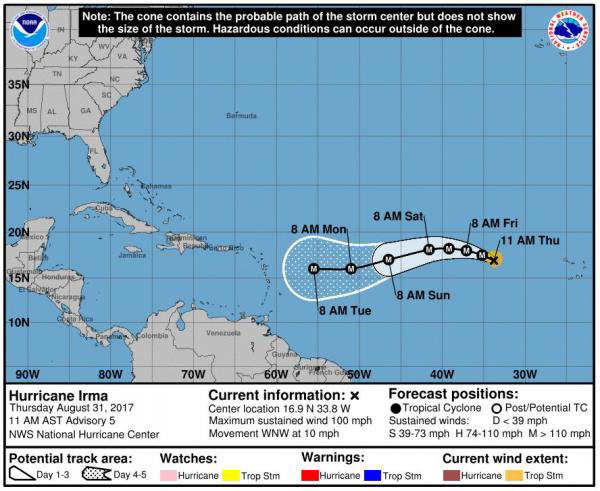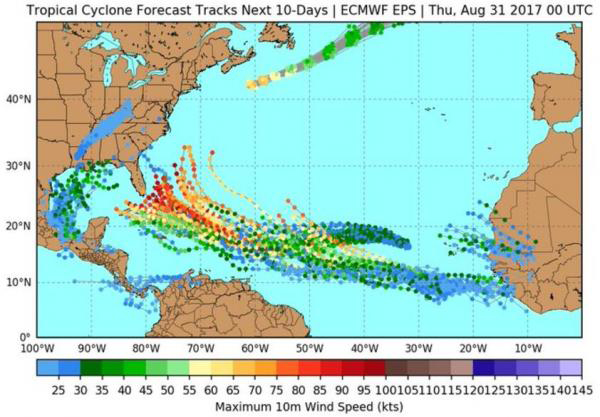"Rapidly Intensifying" Hurricane Irma Barreling Straight Toward The East Coast
Tyler Durden
 The National Hurricane Center (NHC) has just updated its forecast for what it is now referring to as a "rapidly intensifying" Category 2 hurricane in the Eastern Atlantic ocean and the results look disastrous for a large swath of the Caribbean and Southeastern United States. Here is a brief summary of Hurricane Irma from the National Hurricane Center released at 11AM EST: The National Hurricane Center (NHC) has just updated its forecast for what it is now referring to as a "rapidly intensifying" Category 2 hurricane in the Eastern Atlantic ocean and the results look disastrous for a large swath of the Caribbean and Southeastern United States. Here is a brief summary of Hurricane Irma from the National Hurricane Center released at 11AM EST:
Satellite images indicate that Irma is rapidly intensifying. Very deep convection has formed in the central dense overcast, which is now displaying a small and clearing eye. Dvorak estimates were up to 77 kt at 1200 UTC, and since the cloud pattern continues to quickly become more organized, the initial wind speed is set to 85 kt.
At 1100 AM AST (1500 UTC), the center of Hurricane Irma was located near latitude 16.9 North, longitude 33.8 West. Irma is moving toward the west-northwest near 10 mph (17 km/h). This general motion is forecast through early Friday, followed by a generally westward motion on Saturday.
Maximum sustained winds have increased to near 100 mph (155 km/h) with higher gusts. Irma is forecast to become a major hurricane by tonight and is expected to be an extremely dangerous hurricane for the next several days.
Hurricane-force winds extend outward up to 15 miles (30 km) from the center and tropical-storm-force winds extend outward up to 80 miles (130 km).
Irma is expected to grow into a "major hurricane" within the next 24 hours with maximum sustained winds of 120 mph before growing even stronger throughout the weekend and eventually becoming a Category 4 storm.

The storm is moving west at roughly 10 mph and isn't expected to pose its first threat to land until next week.

That said, longer term models suggest that Irma could make a turn to the northwest towards the middle of next week and head straight for Florida.

Meanwhile, other computer models predict that Hurricane Irma will move through the Gulf of Mexico and make its U.S. landfall in Texas just 2 weeks after Hurricane Harvey devastated the state.
That said, a lot could obviously change over the next week and, as the NHC notes, Irma is currently tracking further south than models predicted as of yesterday.
Irma has moved somewhat south of and slower than all of the model guidance since yesterday. Consequently, it stayed longer over the warmer ocean temperatures away from the drier air to the north, possibly allowing the rapid strengthening. Irma should move over cooler waters tomorrow with some increase in mid-level dry air, so hopefully the hurricane's intensity will level off by then. In a few days, the hurricane will be moving over warmer waters with light shear shown by all of the model guidance. This should promote further strengthening of Irma, and the NHC forecast shows an extremely dangerous category 4 hurricane next week, similar to the solutions provided by the HWRF and the ECMWF models. The intensity forecast is raised considerably from the previous one due to initial trends, and is on the high end of the guidance at long range.
Of course, with FEMA resources already stretched thin by Hurricane Harvey, another U.S. landfall of a Cat 4 hurricane could be devastating blow.
 our mission: our mission:
to widen the scope of financial, economic and political information available to the professional investing public.
to skeptically examine and, where necessary, attack the flaccid institution that financial journalism has become.
to liberate oppressed knowledge.
to provide analysis uninhibited by political constraint.
to facilitate information's unending quest for freedom.
our method: pseudonymous speech...
Anonymity is a shield from the tyranny of the majority. it thus exemplifies the purpose behind the bill of rights, and of the first amendment in particular: to protect unpopular individuals from retaliation-- and their ideas from suppression-- at the hand of an intolerant society.
...responsibly used.
The right to remain anonymous may be abused when it shields fraudulent conduct. but political speech by its nature will sometimes have unpalatable consequences, and, in general, our society accords greater weight to the value of free speech than to the dangers of its misuse.
Though often maligned (typically by those frustrated by an inability to engage in ad hominem attacks) anonymous speech has a long and storied history in the united states. used by the likes of mark twain (aka samuel langhorne clemens) to criticize common ignorance, and perhaps most famously by alexander hamilton, james madison and john jay (aka publius) to write the federalist papers, we think ourselves in good company in using one or another nom de plume. particularly in light of an emerging trend against vocalizing public dissent in the united states, we believe in the critical importance of anonymity and its role in dissident speech. like the economist magazine, we also believe that keeping authorship anonymous moves the focus of discussion to the content of speech and away from the speaker- as it should be. we believe not only that you should be comfortable with anonymous speech in such an environment, but that you should be suspicious of any speech that isn't.
www.zerohedge.com
|




